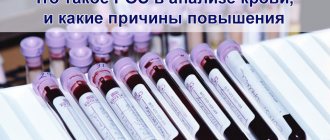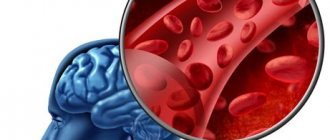Many people are interested in a table that shows the norm of cholesterol in men by age. They want to see it because they have heard more than once about how harmful “bad” cholesterol is, how important it is to monitor it, and that it can increase the risk of developing cardiovascular diseases and atherosclerosis.
But do these statements correspond to reality, how does the level of cholesterol in the blood of men change with age and how can it be lowered? Let's talk about everything in order.
Function of cholesterol in the body
According to its chemical structure, cholesterol belongs to the class of lipophilic alcohols. It is vitally necessary for the body, as it is an integral part of cell membranes and is involved in the synthesis of:
- hormones - testosterone, cortisol, aldosterone, estrogens, progesterone;
- vitamin D3;
- bile acids.
About 80% of cholesterol is produced by various human organs (mainly the liver), 20% enters the body with food.
This substance does not dissolve in water, so it cannot move through the bloodstream on its own. To do this, it binds to special proteins - apolipoproteins. The resulting complexes are called lipoproteins.
Some of them have a high density (HDL), others have a low density (LDL). The former remove excess fat from the body, the latter settle on the vascular walls, participating in the formation of atherosclerotic plaques.
Formation of atherosclerotic plaques
Therefore, when we talk about “good” lipids, we mean HDL, and when we talk about “bad” lipids, we mean LDL. Total cholesterol is the sum of all lipoproteins.
A study of lipid metabolism is carried out in order to assess a person’s risk of developing atherosclerosis and cardiovascular complications.
Despite the fact that men and women have different levels of cholesterol in the blood (the table by age is given below), there are regulated indicators in medicine.
The global network provides abundant information on cholesterol standards. Often, figures are given that absolutely do not correspond to the real ones used by doctors. There are official orders, resolutions, and guidelines that indicate clear boundaries of the minimum and maximum indicators.
Victoria Druzhikina
Neurologist, Therapist
Doctors in their practice are guided by the figures recommended by the World Health Organization. They look like this:
| Meaning | Total cholesterol (indicator, mmol/l) | LDL (indicator, mmol/l) | HDL (indicator, mmol/l) | Triglycerides (indicator, mmol/l) |
| normal | up to 5.0; | up to 3.0 | no more than 1.0 | less than 1.7 |
| elevated | 5,0-6,1 | 3,0-3,5 | 1.0-1.3 for men, 1.3-1.5 for women; | 1,8-2,0 |
| high | more than 6.2 | 3,5-3,9 | less than 1.0 for men, 1.3 for women. | 2,1-2,4 |
| very tall | from 6.5 | above 4.0 | less than 0.7 for men, 0.9 for women. | 2.4 and higher |
In his work, the doctor focuses on the range of values he needs, taking into account concomitant diseases. If a person has diabetes, it does not matter what age he is - his cholesterol should be no more than 5.0 mmol/l. Exceeding this figure worsens the prognosis.
Description of the substance and its functions
Chemical properties: able to dissolve only in fat-containing and organic solvents, not in water. Most of it is produced by hepatocytes - liver cells, about 20% comes with food.
The molecule is a necessary component for the synthesis of vitamins D, as well as sex hormones, including testosterone. In addition, the substance is necessary to maintain the elasticity of the cytoplasmic membrane of the cell over a wide temperature range.
Types of lipoprotein complexes
Due to its insolubility in aqueous solvents, the molecule cannot be transported through blood vessels to organs and tissues. Therefore, the substance is found in the human body in the form of a complex with transporter peptides. The complex is called lipoprotein. There are 3 types of lipoprotein complexes: high density (HDL), low (LDL) and very low (VLDL). They differ not only in the functions they perform, but also in the degree of danger to human health.
How to recognize “good” and “bad” lipoprotein? HDL is considered “good” and makes up approximately 30% of the total. The complex consists predominantly of a peptide part. While LDL contains only a small protein part. The accumulation leads to the formation of plaques in the blood vessels, which impede the free flow of blood, and also increases the risk of developing heart pathologies (heart attack and stroke).
The main part of LDL enters the human body along with fatty foods (meat or dairy), leading to its increase to critical values.
Normal cholesterol level in women
The table shows the normal level of cholesterol in the blood of women of different ages.
| Age, years | Total cholesterol mmol/l | LDL mmol/l | HDL mmol/l |
| 20-25 | 3,0-5,0 | less than 3.0 | more than 1.2 |
| 25-30 | 3,0-5,0 | less than 3.0 | more than 1.2 |
| 30-35 | 3,0-5,0 | less than 3.0 | more than 1.2 |
| 35-40 | 3,0-5,0 | less than 3.0 | more than 1.2 |
| 41-45 | 3,0-5,0 | less than 3.0 | more than 1.2 |
| 46-50 | 3,0-5,0 | less than 3.0 | more than 1.2 |
| 51-55 | 3,0-5,0 | less than 3.0 | more than 1.2 |
| 56-60 | 3,0-5,0 | less than 3.0 | more than 1.2 |
| 61-65 | 3,0-5,0 | less than 3.0 | more than 1.2 |
| 66-70 | 3,0-5,0 | less than 3.0 | more than 1.2 |
| Over 70 | 3,0-5,0 | less than 3.0 | more than 1.2 |
The age of 40 years is the limit after which there is a high probability of developing vascular and heart diseases associated with atherosclerosis.
As can be seen from the table, in women over 50 years of age, the level of normal cholesterol and LDL in the blood is quite significantly increased. This is due to hormonal changes (which are treated by endocrinologists) that occur during menopause. Metabolic processes slow down at this age, and the body requires more energy to process lipids.
Normal blood cholesterol levels in women after 50 and after 60 years
With the onset of menopause, a woman’s hormonal levels change - the body’s natural defenses from many factors, incl. – the risk of cardiovascular pathologies increases. Therefore, after 50 years, it is especially important to monitor the level of cholesterol and its fractions (LDL, HDL, TG). It is necessary to donate blood annually as part of a free medical examination. If deviations are detected, the frequency of examinations and management tactics for the patient are determined by the doctor. The average cholesterol level for a healthy person after 50 years of age is 3.0 - 5.5 mmol/l. In the presence of concomitant pathology (coronary artery disease, arterial hypertension, diabetes mellitus), the indicator should not be higher than 5.0. For people who have suffered an ischemic stroke - no more than 4.5 mmol/l.
Normal cholesterol level in men
Below is the normal level of cholesterol in the blood of men depending on age.
| Age, years | Total cholesterol | LDL | HDL |
| 20-25 | 3,0-5,0 | less than 3.0 | more than 1.0 |
| 25-30 | 3,0-5,0 | less than 3.0 | more than 1.0 |
| 30-35 | 3,0-5,0 | less than 3.0 | more than 1.0 |
| 35-40 | 3,0-5,0 | less than 3.0 | more than 1.0 |
| 41-45 | 3,0-5,0 | less than 3.0 | more than 1.0 |
| 46-50 | 3,0-5,0 | less than 3.0 | more than 1.0 |
| 51-55 | 3,0-5,0 | less than 3.0 | more than 1.0 |
| 56-60 | 3,0-5,0 | less than 3.0 | more than 1.0 |
| 61-65 | 3,0-5,0 | less than 3.0 | more than 1.0 |
| 66-70 | 3,0-5,0 | less than 3.0 | more than 1.0 |
| Over 70 | 3,0-5,0 | less than 3.0 | more than 1.0 |
If you look closely at the cholesterol levels in the table, you will notice that its level in the blood of men after 60 years of age decreases. This is due to a slowdown in metabolism and regression of all body functions. In men, the risk of atherosclerosis and life-threatening conditions (stroke, heart attack) is initially higher. Their heart and blood vessels are not protected by the action of sex hormones. In addition, representatives of the stronger sex are more often prone to bad habits than women.
Who needs to control cholesterol levels?
If a person is healthy, he does not show negative symptoms, he does not need to think about the condition of the blood vessels or check whether the level of h-phen in the body is normal. That is why patients are often not even aware of the increased level of this substance at first.
This indicator should be measured especially carefully and regularly for those who suffer from hypertension or have problems with the heart and blood vessels. In addition, indications for regular tests have the following categories:
- people who smoke;
- those who suffer from hypertension ;
- overweight people;
- patients suffering from diseases of the cardiovascular system;
- those who prefer a sedentary life;
- women after menopause ;
- men after reaching 40 years of age;
- aged people.
Those who need a blood test for cholesterol should ask appropriate professionals about how to take a cholesterol test. The blood formula, including cholesterol content, is determined by a biochemical blood test . How to donate blood for cholesterol? This analysis is carried out in any clinic; for this, approximately 5 ml of blood is taken from the ulnar vein. Those who are interested in how to donate blood correctly should note that before these indicators are determined, the patient should not eat for half a day. Also, in the period before blood donation, you should not engage in intense physical activity.
There is also a special test for use at home. These are disposable test strips that are easy to use. The portable analyzer is used by people with diabetes and lipid metabolism disorders.
Causes of high and low cholesterol
In women and men over 40 years of age, excess cholesterol in the blood may be associated with genetic defects in lipid metabolism, but more often the cause remains unknown. Factors that contribute to increased blood cholesterol levels include:
- liver and gallbladder diseases;
- smoking;
- tumors of the pancreas, prostate gland;
- gout;
- chronic renal failure (the causes and treatment of kidney disease in women are described here);
- endocrine pathology (insufficient production of somatotropic hormone, diabetes mellitus, hypothyroidism).
In women, the cause of increased blood cholesterol compared to the norm can be pregnancy. Those who are planning to get pregnant after 40 need to know this.
Reduced lipid values are observed with:
- starvation, exhaustion;
- extensive burns;
- severe infections (treated by an infectious disease specialist);
- sepsis;
- malignant liver tumors (diagnosed and treated by an oncologist);
- some types of anemia;
- chronic lung diseases (read how to treat chronic bronchitis in this article);
- rheumatoid arthritis;
- hyperthyroidism.
Low blood lipid levels also occur in those who are vegetarians or take medications such as neomycin, thyroxine, ketoconazole, interferon, and estrogens.
What is the atherogenic coefficient?
Many people are interested in what is the atherogenic coefficient in a biochemical blood test? The atherogenic coefficient is usually called the proportional ratio of good and general x-rays. This indicator is the most accurate reflection of the state of lipid metabolism in the body, as well as an assessment of the likelihood of atherosclerosis and other ailments. To calculate the atherogenic index, you need to subtract the HDL cholesterol value from the total cholesterol value, and then divide this difference by the HDL cholesterol level.
The norm for women and the norm for men of this indicator is as follows:
- 2-2.8 – young people under 30 years old;
- 3-3.5 is the norm for people over 30 years of age who do not have signs of atherosclerosis ;
- from 4 – an indicator typical for people suffering from coronary artery disease .
If the atherogenic coefficient is below normal, then this is not a cause for concern. On the contrary, if the coefficient is reduced, then the person’s risk of atherosclerosis is low.
It is important to pay attention to the patient's condition if the atherogenicity coefficient is increased. A specialist will tell you what it is and how to act in this case. If a patient’s atherogenic coefficient is increased, the reasons for this are due to the fact that bad cholesterol is increased in the body. What to do in such a situation? First of all, you need to contact a qualified doctor who will adequately assess the atherogenic index. What this means can only be clearly assessed and explained by a specialist.
Atherogenicity is the main criterion for monitoring how effective hypercholesterolemia . One should strive to ensure that lipoprotein levels are restored. At the same time, it is important to ensure not only a decrease in total cholesterol, but also an increase in high-density lipoproteins. Therefore, decoding the lipid spectrum of the blood provides that β-lipoproteins, the norm for which is different in women and men, as already noted, are necessarily taken into account when assessing the patient’s condition.
Risk groups for high cholesterol
It has been proven that hypercholesterolemia occurs more often in people who:
- eat large amounts of animal fats;
- move little;
- are overweight;
- abuse alcohol;
- smoke;
- take certain medications for a long time (androgens, diuretics, glucocorticoids, cyclosporine, amiodarone, levodopa).
Men over 40 and women over 50 undergo a screening test for blood cholesterol (the norm is indicated in the tables above). It is one of the factors that is taken into account when calculating absolute cardiovascular risk.
Doctor's advice
Nutrition for low cholesterol. You can eat any kind of porridge. If you have poor tolerance to milk protein, you can cook them with water, but it is better with half and half milk and water. There is little cholesterol in milk, especially store-bought milk, but the body needs protein. You can add 1/2 teaspoon of natural butter without vegetable fat to the finished porridge. You can eat this 2-3 times a week. On other days, the porridge should be seasoned with vegetable oil. Today, olive oil is considered the most beneficial in terms of cholesterol. You can also use regular sunflower, sea buckthorn, and camelina. Rapeseed should not be used. Salads should also be seasoned with butter or 10% sour cream instead of mayonnaise.
Victoria Druzhikina Neurologist, Therapist
High and very high absolute risk means that in the coming years a person may suffer from severe and even fatal disorders of the heart and blood vessels.
Hypercholesterolemia is especially dangerous for people suffering from:
- coronary heart disease (therapy is carried out and advised by a cardiologist);
- atherosclerosis of the lower extremities;
- obesity;
- people prone to blood clots;
- chronic kidney diseases;
- hypertension;
- chronic kidney diseases;
- hypertension;
- diabetes mellitus (treated by an endocrinologist);
- collagenoses (for example, rheumatoid arthritis).
These conditions require frequent monitoring of lipids and drug correction if they increase.
Complexes with this research
Expanded hospital complex Expanded infectious screening for prevention and hospitalization RUR 7,700 Composition
Biomarkers of liver functional capacity. Extended examination RUR 3,900 Composition
Monitoring of diabetes mellitus Monitoring of the condition of patients with diabetes mellitus (every 6 months) 1,900 RUR Composition
IN OTHER COMPLEXES
- Biochemistry of blood. 13 indicators 3,490 RUR
- Men's check-up No. 1 RUB 18,570
- Cola and chips RUB 3,020
- Women's check-up No. 1 RUB 19,290
- Preventive check-up RUB 11,960
What to do if cholesterol is high, how to bring it back to normal
Even among young people, starting from 18 years old, with prof. During examinations and medical examinations, blood is taken for total cholesterol. If it is elevated, the doctor gives recommendations for lifestyle changes. Compliance with them can delay the occurrence of vascular atherosclerosis and related complications.
To do this, first of all, you need to change your diet. The following should be excluded from it:
- fatty meat, sausage, smoked meats, lard, offal;
- mayonnaise, fatty sauces;
- fatty dairy products (cream, cheese, sour cream);
- confectionery, flour products;
- carbonated drinks;
- canned foods, semi-finished products;
- alcohol;
- margarine.
In the daily menu it is better to give preference to:
- vegetable salads with the addition of vegetable oil;
- sea fish;
- lean meat;
- fresh vegetables, fruits;
- porridge on water;
- vegetable soups or soups cooked in low-fat broth;
- low-fat fermented milk products;
- mineral water, unsweetened berry fruit drinks, freshly squeezed juices;
- whole grain, rye or bran bread.
Changing your diet: Your health is in your hands
Low physical activity negatively affects the level of “bad” lipids. Therefore, young people should play sports, the elderly and sick should walk at a moderate pace, climb the stairs to their floor.
In women over 50 years of age receiving hormone replacement therapy due to menopausal syndrome, cholesterol increases compared to the norm. Before starting hormonal medications, they should visit a general practitioner or cardiologist.
People who have diseases that are dangerous in terms of absolute cardiovascular risk should constantly take lipid-lowering drugs. These include fibrates, statins, etc. They stabilize atherosclerotic plaques, that is, they do not allow them to collapse. The destruction of the plaque entails necrosis of the vessel or its detachment and entry into the vascular bed in the form of a thrombus. Thrombosis and necrosis of cardiac vessels lead to myocardial infarction, and cerebral vessels lead to stroke.
How to prepare for donating blood for cholesterol?
The biomaterial for research is taken by a laboratory specialist from a vein in the patient’s elbow. The completion time does not exceed 24 hours, not counting the day on which the biomaterial was collected.
More than 70% of errors are made at the preanalytical stage, that is, at the stage of preparing the subject for analysis and during the procedure for taking material. Recommendations for preparing for analysis:
- biomaterial is submitted strictly on an empty stomach, the minimum time interval between a visit to the laboratory and a meal should be 6 hours;
- smoking is eliminated within half an hour;
- per day, adjustments are made to the diet: fatty and smoked foods are excluded;
- physical and emotional activity is limited, as this affects the condition and functioning of tissues in the human body;
- 2-3 days in advance, it is advisable to avoid taking any medications in consultation with your doctor. If cancellation is impossible, you must notify the laboratory employee.
Read more: How long does alcohol stay in the blood; about maintenance standards
Cholesterol lowering drugs
Currently, the following groups of drugs are used to lower cholesterol:
| Group | Action | International name | Tradename |
| Statins | Reduces LDL and triglycerides | "Simvastatin"; "Atorvastatin"; "Rosuvastatin"; "Fluvastatin"; "Lovastatin"; "Pravastatin" | "Simvastol", "Vasilip"; "Atoris", "Liprimar"; "Rocksera"; "Mertenil"; "Leskol"; "Mevacor"; "Lipostat"; |
| Bile acid binding resins | Reduce LDL | "Cholestyramine"; "Colestipol"; "Kolesevelam" | "Questran"; "Colestid"; "VelHol" |
| Cholesterol absorption inhibitors | Reduce LDL and triglycerides, increase HDL | "Ezetemibe" | "Zetia" |
| Fibrates | Reduce triglycerides, increase HDL | "Fenofibrate"; "Gemfibrozil" | "Lofibra", "Trikor"; "Dopid" |
| Combined (statin + cholesterol absorption inhibitor) | Reduce LDL and triglycerides, increase HDL | "Ezetemibe+"Simvastatin" | "Vytorin" |
1st line drugs are statins. The oldest representative is Simvastatin. Its use is justified when you need to slightly lower cholesterol levels, plus it is low in cost, it prevents the creation of new cholesterol deposits, but also does not reduce old ones. Reducing plaque requires a dose that is toxic to the liver.
Rosuvastatin and Atorvastatin are considered the most effective and safe. They have been tested by the practice of millions of doctors and hundreds of clinical studies, and have been proven to reduce the volume of atherosclerotic plaques.
New drugs include Pravastatin; they also effectively combat the problem, but do not have a large evidence base and many years of experience in use.
Taking statins requires mandatory monitoring of liver function. To do this, blood is donated monthly or once every 2 months for liver fractions (ALT, AST). At the same time, cholesterol levels and lipid levels are monitored.
Find out about the normal level of cholesterol in the blood from the video:
This article has been verified by a current qualified physician, Victoria Druzhikina, and can be considered a reliable source of information for site users.
Bibliography
1. https://scardio.ru/rekomendacii/rekomendacii_rko_close/
2. https://scardio.ru/rekomendacii/rekomendacii_esc_close
Rate how useful this article was
4.6 42 people voted, average rating 4.6
Did you like the article? Save it to your wall so you don’t lose it!










